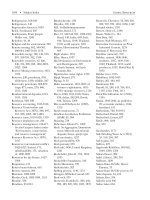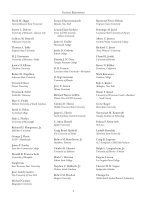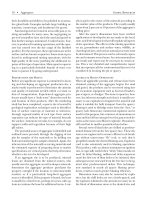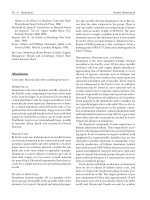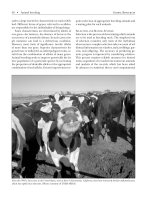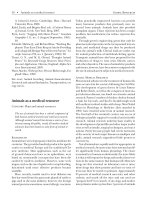Encyclopedia of Global Resources part 1 ppt
Bạn đang xem bản rút gọn của tài liệu. Xem và tải ngay bản đầy đủ của tài liệu tại đây (246.04 KB, 10 trang )
Global Resources
Global Resources
Global Resources
Global Resources
Volume 1
Abrasives - Energy storage
Editor
Craig W. Allin
Cornell College
Salem Press
Pasadena, California Hackensack, New Jersey
Editor in Chief: Dawn P. Dawson
Editorial Director: Christina J. Moose
Manuscript Editor: Christopher Rager
Acquisitions Editor: Mark Rehn
Research Supervisor: Jeffry Jensen
Photo Editor: Cynthia Breslin Beres
Production Editor: Andrea E. Miller
Page Design and Layout: James Hutson
Additional Layout: Mary Overell and
William Zimmerman
Editorial Assistant: Brett Weisberg
Cover photo: ©iStockphoto.com/Guillermo Perales
Copyright © 1998, 2010, by Salem Press
All rights in this book are reserved. No part of this work may be used or reproduced in any manner whatsoever
or transmitted in any form or by any means, electronic or mechanical, including photocopy, recording, or any
information storage and retrieval system, without written permission from the copyright owner except in the
case of brief quotations embodied in critical articles and reviews or in the copying of images deemed to be freely
licensed orinthepublicdomain.For information address thepublisher,SalemPress, at
∞ The paper used in these volumes conforms to the American National Standard for Permanence of Paper
for Printed Library Materials, Z39.48-1992 (R1997).
Library of Congress Cataloging-in-Publication Data
Encyclopedia of global resources / Craig W. Allin, editor.
p. cm.
Includes bibliographical references and index.
ISBN 978-1-58765-644-6 (set : alk. paper) — ISBN 978-1-58765-645-3 (vol. 1 : alk. paper) — ISBN 978-1-58765-
646-0 (vol. 2 : alk. paper) — ISBN 978-1-58765-647-7 (vol. 3 : alk. paper) — ISBN 978-1-58765-648-4 (vol. 4 : alk.
paper) 1. Natural resources. I. Allin, Craig W.
HC85.E49 2010
333.703—dc22
2010001984
printed in the united states of america
Publisher’s Note
From North America to the World
Salem’s critically acclaimed Natural Resources, which
originally appeared in 1998 in three volumes, forms
the foundation for this fully revised and expanded
four-volume set, Encyclopedia of Global Resources. Hailed
by the American Library Association in itsfirstedition
as an Outstanding Reference Source of 1999, Encyclo-
pedia of Global Resources now adds 143 new articles(6 of
which replace superseded entries) to the original 438
entries. All of the original articles have been revised to
extend their scope to our global economy in 2010. All
of the original 135 charts, graphs, and tables have
been updated or replaced, and 110 new charts, tables,
graphs, sidebars have been added, for a total of 235
data-laden sidebars that are easily understood at a
graphic, visual level. Dozens of appendixes illustrate
the text, providing students with worldwide insights
into where we derive our mineral, biological, and en-
ergy resources; how they are processed; for what pur-
poses they are used; and where they stand in our cur-
rent economy.
The coverage touches not only on the economic
applications and benefits of natural resources but also
on their processing, their management, the environ-
mental impact of their extraction, and trends in their
availability—all in easily understood language. The
expanded contents include 40 overviews of top re-
source nations and their significance in the global
context. Specific minerals, organizations, historical
events, and biographies are included as well as articles
on energy and ecological resources. Appendixes pro-
vide both alphabetical and periodic tables of the ele-
ments, along with lists of Major U.S. Mineral Re-
sources, Major U.S. Mineral Resources by State, Major
Canadian Mineral Resource Production and Values,
Major Worldwide Mineral Resources and Producers,
Major Worldwide Resources by Country, a Time Line,
a Glossary, a Bibliography, and a list of Web Sites.
Content Definition
The term “natural resources” has been in general use
since the late nineteenth century, and for many de-
cades discussions of natural resources have formedan
important part of history, anthropology, and social
studies curricula. In the most basic sense, natural
resources have long been defined as naturally occur
-
ring raw materials and phenomena—timber, flowing
water, and minerals such as iron and coal—that are
economically useful to humans, particularly those
materials important to major industries or to a na-
tion’s security. By the late 1960’s, however, concerns
about the world’s growing human population, the fi-
nite nature of many “nonrenewable” resources, and
the environmental and ecological ramifications of
resource exploitation had taken hold. Viewed in a
global context, resource issues rapidly became more
complex. Today one is as likely to hear discussions
of “global resources” as of natural resources, along
with debates over issues such as “sustainable develop-
ment,” “renewable vs. nonrenewable resources,”“eco-
logical resources,” and “energy resources.” This sea
change in the way we view our resources and their in-
tegration into a global marketplace and worldwide
environmental concerns has prompted this complete
overhaul of the original edition, its expansion to four
volumes, and its new title: Encyclopedia of Global Re-
sources.
Contents and Scope of Coverage
Salem Press’s four-volume Encyclopedia of Global Re-
sources provides a wide variety of perspectives on both
traditional and more recent views of Earth’s resources.
In this sense, Encyclopedia of Global Resources serves as
a bridge connecting the domains of resource exploi-
tation, environmentalism, ecology, geology, and biol-
ogy, and it explains their interrelationships in terms
that students and other nonspecialists can under-
stand.
The 575 alphabetically arranged articles in Encyclo-
pedia of Global Resources are as broad as “Agricultural
products” and as specific as “Svalbard Global Seed
Vault.” They range in length from 500 words (about a
page) to more than 3,000 words (6 pages) and cover
topics as diverse as soil, fisheries, forests, aluminum,
the Industrial Revolution, the U.S. Department of the
Interior, the hydrologic cycle, glass, and placer min-
eral deposits. Top resources—119 mineral-based, 41
biologically based, and 39 energy-related (such as oil
and tar sands)—are covered, as well as 40 countries;
32 ecological resources; 50 environment, conserva-
tion, and resource management; 41 geological pro-
cesses and formations; 72 government and resources;
18 historical events and movements; 35 laws and con-
ventions; 49 obtaining and using resources; 71 organi
-
zations, agencies, and programs; 37 people; 22 pollu
-
tion and waste disposal; 23 products from resources;
v
19 scientific disciplines; and 31 social, economic, and
political issues.
In the traditional view of natural resources, the
core of the set is a series of more than one hundred
articles on specific mineral and other nonliving re-
sources, from aluminum to zirconium; more than
twenty overviews were added to the original list of
these mineral resources, while the others were up-
dated. These articles begin with immediately accessi-
ble, informative subheads—“Where Found,” “Primary
Uses,” “Technical [including chemical] Definition”—
and continue with subsections that address “Descrip-
tion, Distribution, and Forms,” “History,” “Obtaining
[the Resource],” and “Uses of [the Resource].” There
are also survey articles on such resource categories
as abrasives, gems, radioactive isotopes, and silicates
as well as on the geologic processes and formations
that produce mineral resources. Reflecting the over-
whelming importance of petroleum products to the
world, a cluster of articles discuss the chemistry, distri-
bution, and formation of oil and natural gas in addi-
tion to oil exploration and drilling, the oil industry,
oil shale and tar sands, and petrochemical products.
Other energy resources, such as hydroenergy,nuclear
energy, solar energy, and wind energy, are also covered
in detail. Two other broad resource areas are discussed
in a number of articles: plant and animal resources,
and what we have called ecological resources, such as
Earth’s atmosphere, biodiversity, forests, medicinal
plants, oceans, water, and even resources deriving
from extraterrestrial exploration of our solar system.
Articles on theformer range from specific crops, such
as corn, to overviews of animal breeding, agricultural
products, and carbon. Articles onthe latter reflect the
realization that, in an increasingly populated world,
natural systems such as rain forests, grasslands, lakes,
and wetlands—from their genetic diversity to the
global biosphere itself—must be considered crucially
important resources, subject to threat and in contin-
ual need of being monitored and protected.
Because the concept of “natural resources” de-
scribes materials useful or necessary to people, this set
includes entries on many aspects of the human di-
mension of resourceexploitation,suchashowvarious
resources are obtained and processed. Also discussed
are the major secondary or intermediate materials
that resources are used to produce; among these arti-
cles are “Carbon fiber and carbon nanotubes,” “Ce
-
ment and concrete,” “Fiberglass,” “Gasoline and other
petroleum fuels,” and “Semiconductors.” Economic,
political, and societal ramifications of resource use
are discussed in essays on energy economics and poli-
tics, the early history of mineral resource use, re-
source exploitation and health, and resource use in
developing countries. A number of articles stress the
environmental effects of human activities related to
obtaining and using resources—air and water pollu-
tion, mining wastes, deforestation, desertification—
as well as phenomena that can be either natural or
caused by humans, such as droughts, erosion, and
fires. Other articles delineate the issues and choices
surrounding resource management, recycling, con-
servation, sustainable development, preservation, en-
vironmentalism, and waste disposal.
Another set of essays cover particularly significant
pieces of legislation, international conventions, and
activities of specific government agencies. Brief arti-
cles highlight organizations, historical events, and
personages important in the history of resource ex-
ploitation, conservation, and environmental protec-
tion. Finally, several overviews of important fields of
study—from agronomy to geographic information
systems to risk assessment—round out the set.
Reference Features
Each article in Encyclopedia of Global Resources is signed,
and each has summary information at the beginning
and cross-references to other articles in the set at the
end. All articles are organized using internal sub-
heads, consistent by type of article, and articles that
are 1,000 words in length or longer concludewithbib-
liographies. Of the 575 essays, 350 also contain sec-
tions that direct users to authoritative Web sites. All
illustrations have been updated or replaced and sig-
nificantly expanded with 235 charts, tables, and
graphs, as well as 200 photos.
A useful reference feature at the beginning of each
volume is a Complete List of Contents, and at the end
of volume 4 are several appendixes: an Alphabetical
Table of the Elements, the Periodic Table of the Ele-
ments, lists of Major U.S. Mineral Resources, Major
U.S. Mineral Resources by State, Major Canadian
Mineral Resource Production and Values, Major
Worldwide Mineral Resources and Producers, Major
WorldwideResourcesby Country, aTime Line, a Glos-
sary, a Bibliography, and a list of Web Sites. Finally,
the set ends with a Category Index that groups similar
essays, along with a comprehensive Subject Index.
vi
Global Resources
Acknowledgments
Salem Press wishes to acknowledge the editors of the
original three-volume edition, Mark S. Coyne of the
University of Kentucky and Craig W. Allin of Cornell
College. For this expanded four-volume edition, Pro-
fessor Allin was instrumental in defining the scope,
coverage, and contents. We also thank the 199 schol
-
ars who contributed original essays, updated their
previous work, and/or wrote new material for this edi-
tion; a list of their names and affiliations appears on
the following pages.
vii
Publisher’s Note
Contributors
McCrea Adams
Independent Scholar
Bland Addison
Worcester Polytechnic Institute
Richard Adler
University of Michigan—Dearborn
Steve K. Alexander
University of Mary Hardin-Baylor
Craig W. Allin
Cornell College
Emily Alward
College of Southern Nevada
S. Ashok
Penn State University
Anita Baker-Blocker
Ann Arbor, Michigan
Grace A. Banks
Chestnut Hill College
Joshua I. Barrett
Charleston, West Virginia
Melissa A. Barton
Westminster, Colorado
Harlan H. Bengtson
Southern Illinois University, Edwardsville
Alvin K. Benson
Utah Valley University
John L. Berkley
SUNY, College at Fredonia
Milton Berman
University of Rochester
David M. Best
Northern Arizona University
Cynthia A. Bily
Adrian, Michigan
Margaret F. Boorstein
C. W. Post College of Long Island
University
Richard G. Botzler
Humboldt State University
Lakhdar Boukerrou
Florida Atlantic University
Judith J. Bradshaw-Rouse
University of Wisconsin—Madison
Howard Bromberg
University of Michigan
JoEllen Broome
Georgia Southern University
Kenneth H. Brown
Northwestern Oklahoma State University
Jeffrey C. Brunskill
Bloomsburg University of Pennsylvania
Michael H. Burchett
Limestone College
Henry Campa III
Michigan State University
Gary A. Campbell
Michigan Technological University
Jennifer L. Campbell
Lycoming College
Byron D. Cannon
University of Utah
Roger V. Carlson
Jet Propulsion Laboratory
Robert E. Carver
University of Georgia
Dennis W. Cheek
Ewing Marion Kauffman Foundation
Kerry L. Cheesman
Capital University
Judy Arlis Chesen
Capital University
Jill A. Cooper
Boise, Idaho
Robert G. Corbett
Illinois State University
Charles V. Cordaro
Pasadena, California
Mark S. Coyne
University of Kentucky
Alan K. Craig
Florida Atlantic University
James R. Craig
Virginia Polytechnic Institute & State
University
Richard A. Crooker
Kutztown University
Robert L. Cullers
Kansas State University
Alan C. Czarnetzki
University of Northern Iowa
Pat Dasch
National Space Society
Jennifer Davis
Kettering, Ohio
LeAnna DeAngelo
Arizona State University
René A. De Hon
University of Louisiana at Monroe
Joseph Dewey
University of Pittsburgh—Johnstown
Albert B. Dickas
University of Wisconsin
John R. Dickel
University of Illinois
ix
